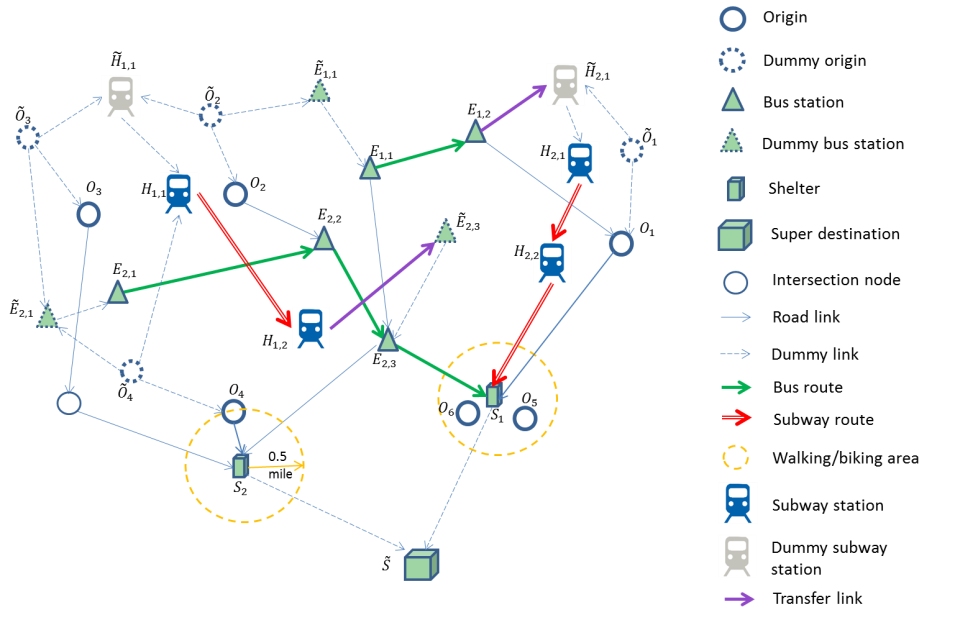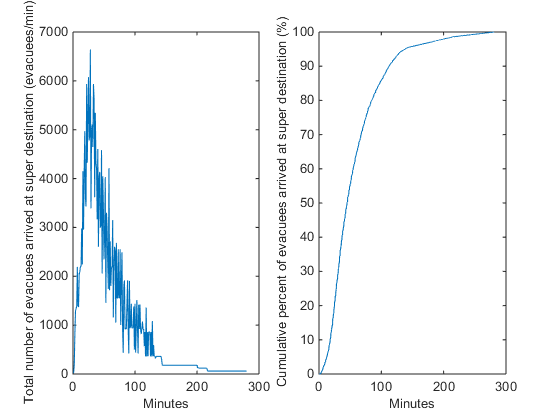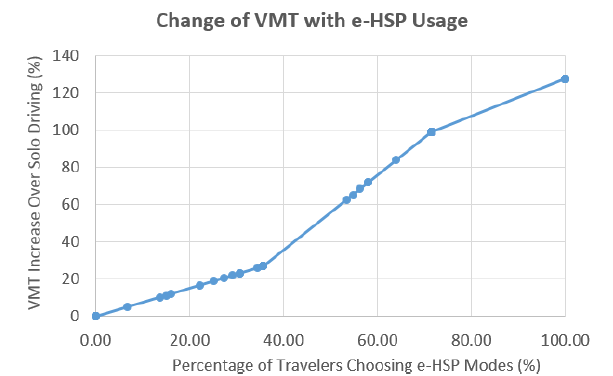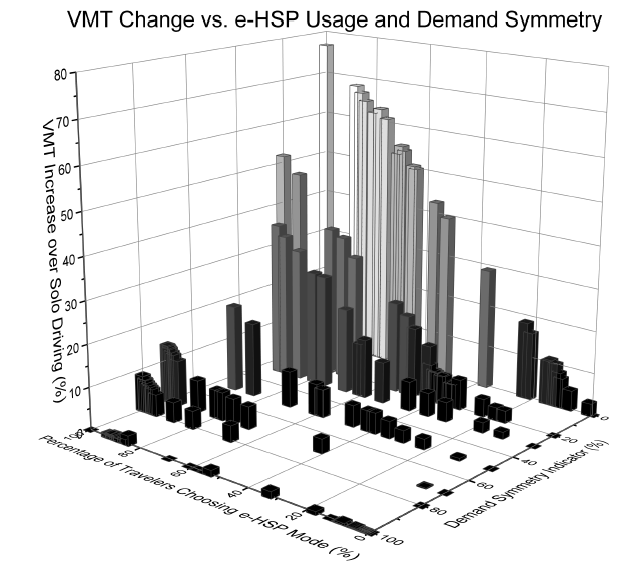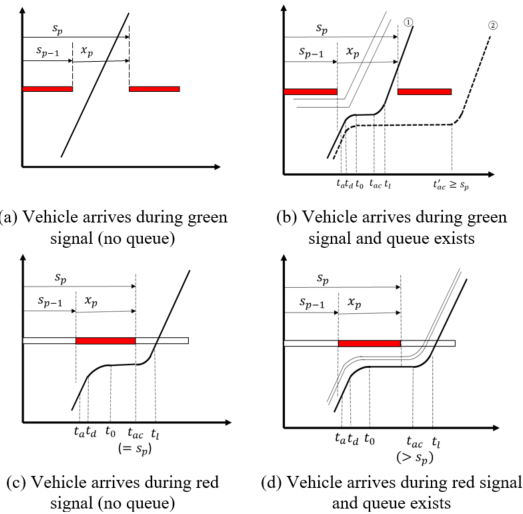Dynamic transportation network modeling, analysis, and simulation (DTN-MAS)
The main purpose of DTN-MAS is to understand the behavior and interactions of major components/players in a multi-modal transportation network, develop mathematical paradigm to model such interactions and behavior, discern deep understanding of the behavior/intersections, based on which to develop novel management policies to manage the multi-modal transportation system more effectively and efficiently. Important applications include emergency evacuation planning and modeling, congestion pricing, among others. This is particularly critical now in the era of connected / automated vehicles, shared mobility, and big data in transportation. The topics we are currently investigating include the congestion effect of e-hailing and ridesourcing services, and how to model and solve the transit first-mile/last-mile problem using emerging shared mobility services.
Below are some specific examples of DTN-MAS related research topics and results iUTS has conducted in the past.
Dynamic User Equilibrium (DUE) and applications
Our iUTS team has worked on developing dynamic user equilibrium (DUE) methods, models, and algorithms for both the continuous-time problems and the discrete-time problems. By collaborating with optimization experts and mathematicians, we were able to apply a new mathematical paradigm, called differential variational inequality (DVI) and its special form of differential complementarity systems (DCS), to model DUE to capture its two major and distinct components, i.e., (i) drivers’ choice behavior (such as departure time, route, and mode choices); and (ii) the network traffic flow dynamics. The former is usually formulated as an optimization problem or an equilibrium problem, while the latter is often formulated as an ordinary differential equation (ODE) or a partial differential equation (PDE). DVI and DCS integrates these two (mathematically very different) components into one consistent and coherent mathematical framework and gives them a formal treatment in terms of solution existence, uniqueness, stability, and solution methods. In particular, we reformulated the Vickrey-type point queue model as a DCS and applied/extended the double queue model for link level traffic flow dynamics. However, DUE problems are inherently more challenging than regular DVI and DCS, mainly due to the time-delayed terms in some of the major components (such as route choice and flow propagations). This requires new developments of the standard DVI/DCS theories, which are challenging yet very interesting problems both mathematically and practically.
Dynamic System Optimum (DSO) and Applications
Dynamic system optimum (DSO) describes and predicts the dynamic traffic network flow from the system perspective by assuming that all drivers are fully cooperative to minimize the total cost (e.g., travel time) of the system. It was widely believed in the past that DSO is less realistic than DUE, which however could provide a benchmark to develop and compare network-wide transportation management strategies such as congestion pricing. The iUTS team has developed continuous-time DSO models that integrates the link-based double queue model. In particular, we showed the solution properties and existence of free-flow DSO models in which all drivers would wait at the origins instead of in the network. Such free-flow DSO solutions are easier to compute and may play some important role in developing future dynamic traffic network management strategies especially when connected and automated vehicles (CAVs) are widely deployed. We also applied the DSO models to network-wide emission pricing and control, and the emergency evaluation planning for Lower Manhattan of the New York City.
Modeling the Network Effect of Shared Mobility
Emerging shared mobility services such as e-hailing, transportation network companies (TNCs), and ridesourcing and ridesharing, are rapidly changing the way how people travel in urban areas. There are however uncertainty regarding how these new services will impact congestion, energy use, and emissions at a network level, as well as how they will compete or complement the public transportation system. The iUTS team has worked on developing network models to capture and quantify those network effects of shared mobility services, including network-level congestion and how they may cooperate with transit to better solve the first-mile and last-mile transit problems.
Traffic Signal Control and Optimization with Connected and Automated Vehicles
Urban traffic signal control, and traffic efficiency and energy use, can be enhanced by the connected vehicles (CV) technology. CV enables the vehicle to vehicle (V2V) and vehicle to infrastructure (V2I) communications through dedicated short-range communications (DSRC) and other means. With the V2V communications, location and speed information can be exchanged among nearby vehicles, leading to improved safety such as collision avoidance and traffic flow efficiency such as platooning. With the V2I communications, vehicles can communicate to traffic signals, work zones, tollbooths, and other types of infrastructures to exchange information such as vehicle trajectories, traffic conditions, signal timing, etc. As a result, CV and V2V/V2I communications can significantly improve traffic mobility and fuel consumption efficiency in urban areas, especially at signalized intersections. By collaborating with vehicle control experts, iUTS research focused on developing CV-based methods to optimize traffic signal timing plans by considering the driving and fuel consumption characteristics of individual vehicles. Some key features we are currently considering include: (i) fixed cycle length so that signal coordination can be done readily for multiple intersection; (ii) different types of vehicles (such as gasoline cars and trucks, electric vehicles, buses, etc.) with their distinct fuel consumption characteristics; (iii) an optimization model that can be approximated as a dynamic programming (DP) problem, with a two-step method to guarantee the fixed-cycle-length solution. The research is supported by the C2SMART (Connected Cities for Smart Mobility towards Accessible and Resilient Transportation) Tier 1 UTC (University Transportation Center) at the New York University, funded by the US Department of Transportation, for which UW is a major partner.
When all vehicles are automated vehicles, the iUTS team, via collaborations with vehicle experts from Tsinghua University, has been working on developing a cooperative method for the simultaneous optimization of traffic signal timing (macro level) and vehicle control (micro level), by considering two objectives: transportation efficiency and vehicle fuel consumption. We consider transportation efficiency at the macro signal timing control level and fuel economy at the micro vehicle control level. This also implies that the primary goal of the proposed method is to ensure the efficiency of all vehicles, while at the same time to minimize vehicle fuel consumption. Such consideration helps decompose the method into two interactive components, which makes the cooperative method easier to construct and solve. The results of this research recently received the Best Paper Award (2nd Prize) from the IEEE Intelligent Vehicles Symposium 2017. The paper is titled "V2I Based Cooperation between Traffic Signal and Approaching Automated Vehicles", and is one of the two papers selected from over 300 papers submitted to the Symposium. The lead author, Mr. Biao Xu, is currently a Ph.D. student of Tsinghua University (under the supervision of Prof. Keqiang Li), who was a visiting student to iUTS from November 2016 to May 2017. He conducted an important part of the research during his visit at UW.
Publications
- Ji. X.F.*, Ban, X., Zhang, J., Ran, B., 2017. Subjective-utility travel time budget modeling in the stochastic traffic network assignment. Journal of Intelligent Transportation Systems, Accepted.
- Yang, X.*, Ban, X., Mitchell, J., 2017. Modeling multimodal transportation network emergency evacuation considering evacuees’ cooperative behavior. Transportation Research, Part A, Accepted.
- Ma, R.*, Ban, X., Pang, J.S., 2017. A Link-Based Dynamic Complementarity System Formulation for Continuous-time Dynamic User Equilibria with Queue Spillbacks. Transportation Science, accepted.
- Di, X., Liu, H, Ban, X., Yang, H., 2017. Ridersharing user equilibrium and its implications for High-Occupancy-Toll lane pricing. Transportation Research Record, accepted.
- Ji. X.F.*, Ban, X., Li, M., Zhang, J., Ran, B., 2017. Non-expected route choice model under risk on stochastic traffic networks. Networks and Spatial Economics, in press. DOI: 10.1007/s11067-017-9344-3.
- Yang, X.*, Ban, X., Ma, R.*, 2017. Mixed equilibria with common constraints on transportation networks. Networks and Spatial Economics 17(2), 547-579.
- Ma, R.*, Ban, X., Szeto, W.Y., 2017. Emission modeling and pricing on single-destination dynamic traffic networks. Transportation Research Part B 100, 255-283.
- Luo, L., Ge, Y., Zhang, F., Ban, X., 2016. Real-Time Route Diversion Control in a Model Predictive Control Framework with Multiple Objectives: Traffic Efficiency, Emission Reduction and Fuel Economy. Transportation Research Part D 48, 332-356.
- Di, X., Liu, H., Ban, X., 2016. Second best toll pricing within the framework of bounded rationality. Transportation Research Part B 83, 74-90.
- Zhao, J., Li, W.*, Wang, J., Ban, X., 2016. Dynamic Traffic Signal Timing Optimization Strategy Incorporating Various Vehicle Fuel Consumption Characteristics. IEEE Transactions on Vehicular Technology 65 (6), 3874-3887.
- Sánchez-Díaz, I., Holguin-Veras, J., Ban, X., 2015. A time-dependent freight tour synthesis model. Transportation Research Part B, 78, 144-168.
- Sun, Z.*, Ban, X., Hao, P.*, Yang, D., 2015. Trajectory-based vehicle energy/emission estimation for signalized arterials using mobile sensing data. Transportation Research Part D 34, 27-40.
- Ma, R.*, Ban, X., Pang, J.S., Liu, X., 2015. Approximating time delays in solving continuous-time dynamic user equilibria. Networks and Spatial Economics 15(3), 443-463.
- Ma, R.*, Ban, X., Pang, J.S., Liu, X., 2015. Time discretization of continuous-time dynamic network loading models. Networks and Spatial Economics 15(3), 419-441.
- Yushimito, W.*, Ban, X., Holguin-Veras, J., 2015. Correcting the market failure in work trips with work rescheduling: an analysis using bi-level models for the firm-workers interplay, Networks and Spatial Economics 15(3), 883-915.
- Ge, Y.E., Stewart, K., Sun, B., Ban, X., Zhang, S., 2014. Investigating undesired spatial and temporal boundary effects of congestion charging. Transportmetrica B: Dynamics, in press.
- Ma, R.*, Ban, X., Pang, J.S., 2014. Continuous-time dynamic system optimal for single-destination traffic networks with queue spillbacks. Transportation Research Part B 68, 98-122.
- Yushimito, W.*, Ban, X., and Holguin-Veras, J., 2014. A two stage optimization model for staggered work hours. Journal of Intelligent Transportation Systems 18(4), 410-425.
- Sanchez, I., Holguin-Veras, J., and Ban, X., 2014. A time-dependent freight tour synthesis model. In Proceedings of the 93rd Annual Meeting of Transportation Research Board, Washington, DC.
- Yushimito, W.*, Ban, X., Holguin-Veras, J., 2013. Correcting the market failure in work trips with work rescheduling: an analysis using bi-level models for the firm-workers interplay, Networks and Spatial Economics, in press. DOI: 10.1007/s11067-013-9213-7.
- Di, X., Liu, H., Ban, X., and Yu, J.W., 2013. One the stability of a boundedly rational day to day dynamic. Networks and Spatial Economics, in press. DOI: 10.1007/s11067-014-9233-y.
- Di, X., Liu, H., Pang, J.S., and Ban, X., 2013. Boundedly rational user equilibria (BRUE): Mathematical formulation and solution sets. Transportation Research Part B 57, 300-313.
- Ban, X., Ferris, M.C., Tang, L., and Lu, S., 2013. Risk-neutral second best toll pricing. Transportation Research Part B, 48(2), 67-87.
- Ban, X., Pang, J.S., Liu, X., and Ma, R.*, 2012. Continuous-time Point-Queue Models in Dynamic Network Loading. Transportation Research Part B, 46(3), 360-380.
- Ban, X., Pang, J.S., Liu, X., and Ma, R.*, 2012. Modeling and Solution of Continuous-Time Instantaneous Dynamic User Equilibria: A Differential Complementarity Systems Approach. Transportation Research Part B, 46(3), 389-408.
- Ban, X., Ferris, M., Liu, H., 2010. Numerical studies on reformulation techniques for continuous network design problems with asymmetric user equilibrium. International Journal of Operations Research and Information Systems, 1(1), 52-72.
- Yushimito, W.F., Ban, X., and Holguin-Veras, J., 2010. Staggered work hours: a bi-level model and the role of incentives. In Proceedings of the 3rd International Symposium on Dynamic Traffic Assignment.
- Ban, X., and Liu, H., 2009. A link-node discrete-time dynamic second best toll pricing model with a relaxation solution algorithm. Networks and Spatial Economics 9(2), 243-267.
- Ban, X., Liu, H., Ferris, M.C., and Ran, B., 2008. A link-node complementarity model and solution algorithm for dynamic user equilibria with exact flow propagations. Transportation Research, part B, 42(9), 823-842.
- Ban, X., and Liu, H., 2007. A link-node discrete-time dynamic second best toll pricing model with a relaxation solution algorithm. Presented at the 86th Transportation Research Board Annual Meeting and submitted for publication .
- Ban, X., Liu, H., and Ran, B., 2005. A link based quasi-variational inequality model for dynamic user equilibria, towards real time traffic operations. In Proceedings of the 8th IEEE International Conference on Intelligent Transportation Systems (CD-ROM).
- Yang, F., Liu, H., H, R., Ban, X, and Ran, B., 2003. Bi-level formulation for optimal traffic information dissemination. Transportation Research Record 1836, 21-28.
- Liu, H., Ban, X., Ran, B., and Mirchandani, P., 2003. Formulation and solution algorithm for fuzzy dynamic traffic assignment model. Transportation Research Record 1854, 114-123.
- Liu, H., Ban, X., Ran, B., and Mirchandani, P., 2002. Analytical dynamic traffic assignment model with probabilistic network and travelers’ perceptions. Transportation Research Record 1783, 125-133.
Notes: * indicates graduate students Dr. Ban has advised at UW and RPI











